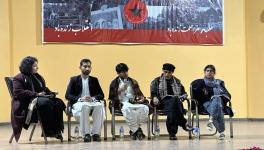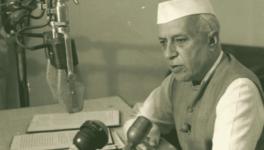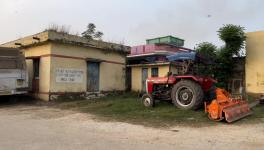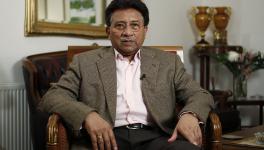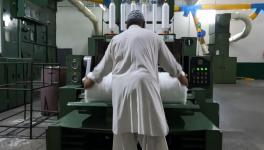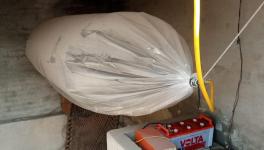Politics of the Oppressed in Pakistan.
The formation of the Anjuman-e-Mazareen-e-Punjab (Association of Punjab’s Tenants) in Pakistan signaled the re-carving of political space by Punjab’s peasants. This interview with Asad Farooq, Professor in the Law Department at LUMS, charts the development of Anjuman-e-Mazareen-e-Punjab from its formation to its recent struggles. The interview was conducted by Qalandar Bux Memon, co-editor with Madiha R. Tahir and Vijay Prashad of Dispatches from Pakistan (LeftWord, 2013).
Qalandar Bux Memon is editor of Naked Punch and co-founder of Café Bol, a cultural and political café in Lahore, Pakistan. He is the co-editor of Dispatches from Pakistan (New Delhi: LeftWord, 2013).
 |
|
Qalandar Bux Memon |
 |
|
Assad Farooq |
Asad Farooq is a professor at the Mustaq Ahmad Gurmani School of Humanities and Social Sciences at the Lahore University of Management Sciences in Lahore, Pakistan.
Qalandar Bux Memon (QM): Professor Farooq, you have worked with peasant movements across Pakistan. The Okara peasants’ movement of 2000 appears to be a landmark. Can you brief us as to what the struggle was around?
Asad Farooq (AF): The peasant movement against the Okara military farms is what you are referring to. Before we head into the movement itself, the history of the military farms is important to understand – to build context.
During the British period, as part of the Punjab’s canal colonisation, the British set up military farms. The military farms needed tenants since military men could not cultivate the farmland themselves. The British administration needed diggers and cultivators to make the land productive, and so cultivators from East Punjab were brought to West Punjab to clear the land, to build canals, to cultivate the land, and to settle. The process spanned over thirty to forty years. These settlers from East Punjab were made promises that they would be granted land rights. The settlement processes around the Okara farms are replicated across Punjab at a number of military farms. The military farms were kept by the British to keep horse-stables, or produce crops to feed the British Indian Army. Thus, cultivators were settled onto the military farms and took the legal status of ‘tenants.’ Tenants were bound to share crop: they gave 50 percent of their crop to the military and kept 50 percent of the crop themselves. The original lease agreement was between the British Indian Army and the imperial Punjab government. The lease began in 1913 and ran out in 1933, and was then renewed for an additional 5 years (till 1938). While the lease expired in 1938, the Military did pay rent to the Punjab govt. until 1943. They stopped paying rent after that date. 1933. However, this contract remained hidden until 2000 when the peasant farmers looked into the matter. During the entire period after the lapse of the lease, the British and Pakistani militaries continued to extract 50 percent of the crop from the tenants. In 1947, de facto ownership was transferred to the Pakistani military which continued the arrangement.
The land where the struggle is happening is around 68,000 acres in the district of Okara. Around a million people are connected to these farmlands – either directly or indirectly.
The trouble began when the Pakistan Army tried to stir the status quo at the farms. In 2000, with General Musharraf in power, the military decided to expand its tentacles into the economic life of the country. It decided to change the relation of peasants to the land. From tenants, the military asked the farmers to be contractors. The shift would give the military legal power to evict the peasants from the land after the end of the contract period. This is when the contest began
QM: The military starts forcing people in 2000 onwards to sign various contracts, how much success did they have initially, when did the movement start organising against this and what form has this organising taken since?
AF: The movement organised itself straight away in 2000.
It’s a typical peasant movement organising around ownership of land but some of the dynamics of this movement have made it particularly unusual.
For a start, it is located in the Punjab which is the heart of the Pakistani military, which itself is the most powerful institution in the country. So, you have in the center of Punjab a movement that is fighting the military. If you look back and think about the time, that is, during the early period of Musharraf’s rule, you had no one challenging the military. After civilian rule in the 1990s, everyone welcomed the military, including the liberal and intellectual elite. Thirdly, the movement is a million strong. Minorities also play a leading role in the movement. 30 percent of folks involved in the movement are Christian. In addition to that, the role of women in the movement has to be noted.
Women were at the forefront of all the resistance to the violence of the military. When the military would lay siege to villages by surrounding them, medical provisions were limited, they wouldn’t let doctors in, they wouldn’t let patients out, and so we are looking at a period where extreme brutality in the army. During this period, the women would form the first circle of resistance and keep the army at bay from entering the village or from taking the leaders out of the village. They would put their bodies on the line. It is extremely unique for those sets of reasons. And extremely powerful and hugely significant at the time where there was no other resistance happening in Pakistan on that scale. The Lawyers’ movement and all these other movements started 7 to 8 years later.
QM: How did the movement evolve? And how do activists and intellectuals of the Left react to this movement?
AF: It had an organic growth, it organized itself. We are talking about self-organization. The Left do get involved and play a facilitative, healthy type of engagement in the movement, in the way they connect it to wider struggles across the country and also to struggles across the world. So the movement is represented in various social forums: the Irish social forum and the World Social Forum, for example. So, that’s the traditional Left . The other side of the coin is the involvement of more civil society sectors and the NGO crowd.
For example, you have some solid involvement by the lawyers who are taking up a number of the cases which is fantastic but, on the other hand, you have the standard NGO involvement. We don’t need to talk about the foundation of the NGO culture and how they historically have been used, in part, to depoliticise countries. In the Okara movement, we have a very clear example of what happens here, when an NGO gets involved. The NGOs want to get the peasant movement to start to articulate itself in the framework of development discourse. Clear political demands are being reframed into “we want better roads or we want better schools. ” The demands were for land, and with land, as Fanon told us many years ago, comes dignity—comes everything. And that is their struggle. Their struggle is not about having better roads or better education. That comes with that land. And what the NGOs did was highly problematic and highly unaccountable.
Secondly, they create divisions within the movement. For example, ActionAid proceeds to distribute funds to the movement, funds with which there are issues of accountability. These are largely channeled to the leaders. The NGO has no accountability to the rest of the movement and has had no conversation with the rest of the movement. They had conversations with part of the leadership, gave the leadership significant amounts of money and as a result, deeply fractured the movement. At that time, the leadership was primarily Christian, the NGOs having engaged with them and funded them invoked levels of mistrust amongst members of the movement that deeply fractured the movement on religious lines. It is not that the NGO gave them money because they were Christian but that they got money and the necessary power that comes with this NGO support led to fragmentation in the movement for a time.
The fact that the movement remained and that these communities remain in control and in occupation of their land is important. The changes that have taken place from 2000 till today 2011 are immeasurable.
QM: Can you talk about some of the changes?
One of their constant refrains one hears around Okara is that actually independence never came to them in 1947 but in 2000. For it is then that structures of power were broken. This is a community, which in 2000 was amongst the most oppressed in Pakistan. You know, a military man would come, sit on a chair and the entire village would appear and sit in front of him and split their crop in front of him.
Before 2000 you were told what you can grow, where you can grow it; you were told how much you must give to the military; you were told where you can grow and also where you were to live. These villages are called chaks. Historically, they were organised by the British: the Christians would live in one corner, the market would be in one area. You could not go outside that grid. These structures remained in place all the way up to 2000 for these communities. They couldn’t go outside the chaks,. They couldn’t grow crops as they liked. Everything they made was regimented. Everything was organised, and nothing allowed to change. The rigidity was enforced by extreme violence, constant beatings, and tortures of various kinds. So, what happens in 2000 is a radical transformation. With the military gone, power and decision making is localized and democratized.
QM: Can you talk about the redistribution of land among them? How do they farm and organise themselves within this new freedom?
AF: Before the movement the farmers would give 50 per cent of whatever they grew to the military and keep 50 per cent for themselves. Now they keep everything. They grow what they want; their land is their own. One of the interesting dynamics within the movement is that some of these communities had people who didn’t have any land, so there were various moments within the movement where land was distributed to those without land.
But the wider effect is that there’s debate about how we should organise, what we should do from now on. And, those debates are ongoing; I don’t think there’s a resolution to these debates. But now these are debates from a position of power. It’s a debate amongst tenants owning their own land. The military continues to make incursions now and then to lay claim to the land. It’s not a dead issue, but aside from defending the gains, the questions of what to do and how to organise are on-going.
QM: Explain a bit more about the tactics that the peasants have used, I mean the military is obviously powerful with modern weapons and all and the peasants don’t have any such weapons?
AF: I remember once in 2002, when the military had surrounded numerous villages, and the villagers were on the periphery of the village, armed to their teeth, ready to respond to any military incursion. A military incursion would be about going in, taking one or two people of the leadership. That’s one of the key tactics of the military: just this constant presence, constant sense of fear, constant pressure and constant picking one or two people here or there, so if someone wants to go to the hospital, a child is ill, they just pick them up. I have seen children die because the military did not allow them to go to the hospital. That was their tactic, the response was equally simple and clearly equally effective – huge demonstrations, blocking of roads and wiliness to fight on.
The villages responded with arms. It was not a peaceful movement. They defended themselves with arms.
They would also block traffic. They would call huge demonstrations, tens of thousands of people. One of the advantages this movement was its proximity to Lahore. It lies on the Grand Trunk Road (GT road), one of the major highways in Pakistan. If you manage to block GT Road, it’s a huge statement. So, its proximity allows a certain voice, a certain loudness that other movements across Punjab don’t get. In Southern Punjab, you have similar kinds of organisations and similar kinds of struggles, but the ability of those movements to make statements by blocking major roads isn’t possible.
QM: Today these communities have the land; they occupy the land and they live on the land. How do the peasants claim it as theirs? What are the bases of this claim?
AF: These are the communities that moved here a hundred years ago, primarily from East Punjab. Their ancestors cleared the land, built these canals, made these lands. The peasants’ claim rests on that memory. There is the entire discourse that they have constructed around that memory, and that is the key for the movement: that this is our land. And related to that, is a fear of what it means to be landless. Because a lot of them were landless when they came here from East Punjab and they also know what it’s like to be dispossessed, so it was that kind of fear of dispossession and that memory of their forefathers, of having tilled this land, having created this land and having given it the value that it has. That is their claim: “We have been here for 100 years.” It’s not a claim that you can ignore.
QM: A set of movements you have been involved with in Punjab is the sath, a form of people’s law. What is a sath and how does it translate? What areas are governed by sath? What is your involvement? Finally, can you explain how the experience of law and justice differs between state law and the people’s sath?
AF: The experience of sath began in Southern Punjab. Before we begin to explain the sath, it is important to understand the position of Southern Punjab within Punjab and Pakistan. The communities settled in the South are heavily impoverished, marginalised and subject to a peculiar form of displacement within their own territory. This form of extraction involves the settlement of Central Punjabis and the establishment of new farming practices. Using David Harvey’s words, we can describe what’s happening in Southern Punjab as ‘accumulation by dispossession.’ But in other ways, it constitutes primitive accumulation, the first stage of capitalist growth, in which people are displaced and land is taken through either a form of brute force or pure extraction or a combination of the two.
The socio-political questions in South Punjab centre on land and water. Last year’s floods have put into question the whole irrigation structure of Pakistan. Questions are being asked about the role of man-made irrigation structures and their contribution to the scale and extent of the floods. But the questions do not begin in 2010. Resistance around irrigation projects in Southern Punjab has continued from the year 2000 onwards. The struggle against the Chashma Right Bank Canal is worth recalling. One of the interesting things about Southern Punjab is that its marginalisation has meant that the state’s presence has been limited. In this context, irrigation projects are one of the ways in which the state has expanded its presence.
The British knew this 150 years ago and the Pakistani state knows this now. A reading of early British irrigation policy reports reveals how irrigation projects are conceived of as projects of social engineering. For example, the report on the Sukkur barrage built in 1920 reveals that the British considered controlling water as a means to control ‘savages’ and settle ‘nomads’. The control of water was essentially a project to control populations or segments of populations. ‘We control water, we control them’ was the colonial thinking. And the post-colonial Pakistani state has continued the same policy, which slowly found its way into Southern Punjab. Irrigation experiments have historically been conducted in certain parts of Southern Punjab, however, the right bank of the Indus River remained untouched by irrigation interventions until the Chashma Right Bank Canal. The area was historically irrigated by hill torrents (rowd kohee). The British recognised that and formalised the structure of the hill torrents. The catchment area of these hill torrents is 1500 miles deep into Afghanistan and feeds into the hill torrents of the Suleiman range. When the water would end up in the Suleiman range, the settled communities would band together and build small, temporary dams to slow and store the incoming water. They would then disperse the water through a system of sharing. The British recognised that they could not build canals to alter the hydrology of the area and, as a result, they decided to formalise the rowd kohee system. The intricate system of social relationships built around the process of managing water was codified within law.
The formalisation meant the creation of a rowd kohee department. The rowd kohee department was tasked with ensuring that communities downstream would partake in the creation of temporary dams upstream. The department was also given legal power to fine those who did not contribute to the management of the rowd kohee’s water management.
QM: Did the formalisation of the rowd kohee system change the social relationships and sanctions around water management? Did it change who was responsible for the management of the system?
AF: Yes. The transfer of sanction and enforcement powers to the rowd kohee department meant that a water management system that had previously been managed locally became dependent on the state. This singular transformation brought about by legal-formalisation contributed to the downfall of the system once Pakistan was established
QM: So what changed after the transfer of power to Pakistan? How did the post-colonial state think about the rowd kohee? What affect did this have on the social structure of the area?
AF: After independence, the post-colonial Pakistani state, driven as it was by the modernist fantasy of dams and mega-canals, showed no regard for traditional ways of irrigating. Similar neglect met the rowd kohee system. Funds were withdrawn from the department and a previously active department was reduced to shambles. The current rowd kohee department office in Dera Ghazi Khan is a small, dingy room manned by one official who sits there doing absolutely nothing. The only things populating the place are tons of old files, which are interesting records of history. But the place has no present. It is completely dysfunctional.
QM: So how does the Chashma Right Bank Canal alter the hydrology of the area?
AF: So when the canal is conceived of, it runs through an area that is historically irrigated by the rowd kohee system. Suddenly you have a canal that’s coming with all the attendant state machinery that comes along with any canal. You swiftly have the state establishing itself in an area where it really didn’t have much role before. You suddenly have the police, the irrigation officers, and the water officers patrolling the area. There’s an entire new restructuring of societies in these areas.
QM: So how did people view the canal project? We heard an inspection claim was filed by the locals which the Asian Development Bank (ADB) accepted. How did the inspection claim work? What was the local response to the process?
AF: So when this primarily ADB funded project comes along with various failures in its planning and implementation, the communities decide to file an inspection claim with the ADB. Now the inspection claim process is supposed to proceed as follows: affected communities go to the ADB with their grievance, file an inspection claim and the process begins. ADB then sends out an inspection panel to assess what happened and arrive at a judgement on the validity of the communities’ grievances. Various types of compensation may then be dispersed to the communities concerned. Now when the community filed this inspection claim, the ADB contrived this wonderful strategy to defer the inspection panel actually conducting the inspection for a while while they tried to address the grievances.
QM: So how did the community deal with the bureaucratic inspection process? This is where the space for people’s law came to be imagined, I believe. Can you take us through the process through which the communities decided that the ADB run process was insufficient?
AF: The communities turned around and said “you’re violating your own process. Your process stipulates that when someone files an inspection claim, if the inspection claim is accepted, then the inspection must be done and it shouldn’t be deferred.” This was only the second time in ADB history that an inspection claim had been accepted, and so for it to be accepted was in itself a recognition of the failure of this project. With the deferral of the inspection, the communities turned around and exclaimed “well, why are we even involving ourselves in this inspection process? Why are we speaking to power to address its own failures?” There was this remarkable moment over a period of six months to a year when people began to realize that they need not engage with the state. This realization materialized in sets of villagers forming what I would hesitantly call ‘people’s tribunals.’
QM: Can you explain what a people’s tribunal is? And how did it affect community organising around the Chashma Right Bank Canal?
AF: People’s tribunals are people coming together and laying claim to the power to judge what happened. In this case, there was more than judging; there was also a sense of controlling the results of the judgement. In short, people became authors of their own livelihoods. So you have this remarkable coming together of these communities who are then turning around and discarding state authority. The first set of villagers who began having these tribunals in the evening were saying “actually, this is what’s happened, this is our testimony of what’s happened, this is what we understand by this and this is what we think we should do” and passing judgement on those who have been involved, on the ADB, on the government, and on the irrigation department. The concept of people’s tribunals touches on traditional articulations of coming together to craft resolutions, but here it was taken a step further by making tribunals part of a broader political struggle.
These tribunals began to spread across villages as activists within those communities embarked upon long marches of over 200 kilometres from the North all the way to the South of Punjab, from village to village, having important discussions and establishing tribunals. These tribunals were then combined into very large tribunals in which the ADB and the government were invited. Predictably, they often didn’t turn up, however, on rare occasions, they did. Moreover, what was particularly unique about these tribunals was that you heard the types of articulation in the Saraiki language that hitherto had been unheard of. Saraiki language has never really been used as a tool for these kinds of demands. So not only does the tribunal become a forum for passing judgement on something, in authoring a different type of understanding of what had happened, but it also becomes part of the Saraiki struggle for due recognition of their language.
QM: Authorship of events by communities and not the state is the key change that you suggest took place. Can you explain further what happens when people’s tribunals become the language of articulating the communities’ demands? Were the communities able to achieve anything from the process? And what did the articulation of people’s law through the sath mean for state law?
AF: So suddenly you have these tribunals in which the Saraiki language is the primary language of articulation of demands, a language that isn’t even recognized by the Pakistani state. When the ADB would come to these tribunals conducted in Saraiki, their understanding or lack of understanding was almost irrelevant to the process. This was another way in which these communities rejected the authority of the state and its agents.
An example of what these people’s tribunals have accomplished is that to this day, in the entire stretch of the third stage of the canal project, which is over 170 kilometres long, no one pays irrigation tax. Moreover, when there are threats of flooding, people would breach the canal when they need to. There is this constant, everyday resistance that has grown out of this tribunal process. It has become an incredible forum, or incredible mode of articulating, in which people are actually laying claim to crafting the law. And that’s the key: it’s no longer a claim to the state; it’s a claim to themselves, a claim that they have the power and authority to craft law.
QM: So the state no longer crafts the law. It is the people. That is an interesting idea.
AF: We have this fetish that either the state is the institution that crafts and administers the law or that people are governed through customary law. These people’s tribunals were outside these two categories. They were deeply imbricated in the political struggle, and the political struggle is what gave it its shape and its flavour. The beauty of these tribunals is that they reclaim the crafting of law, reclaim the ability to actually say “we are the ones who do law, we are the ones who want to articulate judgements and we are the ones who craft the law that stems from that.”
QM: One of the criticisms of sath is its male dominance. Do participants see the lack of female participation as a problem and, if so, do they take any steps to redress this?
AF: I think the way we measure law is the key here. We automatically raise the state versus sath as an example of the way we understand law. For me, that’s a flaw in understanding law. There’s no difference between the two. Let’s be clear: female participation in the state system is equally marginalised. So measuring ourselves to a certain standard is something we need to step away from. These tribunals are organic kinds of growth around struggle. And of course those struggles had dynamics in which gender relations were either ruptured or replicated and that’s issue the struggle has to address and not necessarily the tribunal. Don’t get me wrong, we have saths which are heavily dominated by women, so it’s incorrect to say that all saths are male-dominated. Nonetheless, I don’t think it’s the tribunals responsibility to address the issue of gender relations; it’s a question the struggle and the communities themselves need to pose themselves. And they do increasingly so.
QM: When a judgement is passed, it has no legal recognition in terms of the state’s legal apparatus. How is the move from articulation to action then made?
AF: Communities lay claim to self action; to having the ability to enact that judgement.
QM: Can you give an example?
AF: Refusal to pay irrigation tax. These were decisions made at tribunals and to this day they are not paying irrigation tax.
QM: And how did the state respond to that?
AF: The state responded in various ways. It tried to buy people off or forcibly extract, but these attempts failed. It’s important to keep in mind that people’s tribunals make claims upon its participants. They do not make a claim to somebody else to enact their resolutions. It’s a claim upon participant communities do implement the resolutions. The saths and their resolutions remind me of similar articulations around the world, for example the Algiers Declaration of Self Determination, where Algerians came together and articulated self determination in a particular way, which was totally unrecognized by international law. And yet this remains one of the most beautiful documents on self determination that has ever been produced and international law’s lack of recognition of that is irrelevant. Its power remains nonetheless. The documents that are being produced at these saths, the judgements that are being made, and these claims to law that are being produced are what’s important.
QM: Let’s briefly talk about the Saraiki issue in Pakistan. Tell me a bit more about Saraiki nationalism. Who are the Saraikis?
AF: The Saraiki movement would be really hard to delineate in coherent narrative. What we can say is that Saraiki identity has primarily been based around the Saraiki language. The Saraiki belt runs from anywhere starting from Dera Ismail Khan southwards to Multan. Bahawalpur would also be included.
QM: Are there Saraikis outside of Punjab?
AF: Yes. There are a significant number of Saraiki-speakers in North-East Baluchistan and Southern Khyber Pakhtunkhwa. Saraiki identity is very much a linguistic-based identity. Now, this articulation of Saraiki identity does not have a long historical trajectory; it emerges post-partition. The Saraiki language, however, certainly does.
The most important thing to bear in mind here is that the Saraiki-speaking belt of Pakistan has been historically marginalised. The Pakistani government, which should be committed to advancing the welfare of all its citizens, has shown little interest in developing the Saraiki region. Saraiki is not even a recognised language and if you look at simple statistics, for example the number of Higher Education Commission of Pakistan (HEC) recognized institutions, you can count on one hand how many there are in the Saraiki region. There are around seven HEC recognised institutions in the Saraiki region. To compare, Lahore has more than the entire Saraiki region, with approximately 32 HEC recognised institutions. This is astonishing!
What is also interesting here is that, unlike many parts of Central and Northern Punjab, Southern Punjab has land that is still available for allotment. And so when the new agricultural scheme was announced, where agricultural university graduates were given an amount of land, the land which was given was mostly from Southern Punjab. University students primarily from Central Punjab are being allotted land in Southern Punjab, a process which in many ways mirrors the colonial-settler dynamic. And this foreign settlement is being distinctly felt in these communities. The irrigation model of state craft enables this process – irrigation opens up those lands which then allow people to move in and settle on them until they make those lands cultivatable. This is the dynamic that’s taking place in Southern Punjab. In response, these communities are making a very simple claim: “what about us? What about our language? What about our communities and our economies?” This is a very simple claim to self determination.
QM: Let’s look at the other side: what is recognized by the state. What languages can one use in court?
AF: It depends which court you go to. You can get away with English, Urdu and Punjabi. Proceedings in Supreme Court are usually in English. Let’s be clear, our legal system has this very coffee room feel to it in the sense that you can go to the court and it’s like you are sitting in front of a fire and just having a chat with the judge. You can switch to Punjabi every now and then, and you even have Supreme Court Judges who curse in Punjabi as they are listening to depositions. Unfortunately, I haven’t come across Saraiki as one of the major languages in court.
QM: Discussing the Saraiki situation reminds me of the situation in Sindh and Balochistan. What is the relation between these identity-based struggles?
AF: I think looking at capital’s incursions and the way capital accumulates is key. David Harvey, who we mentioned a moment ago, is very useful in getting your head around these dynamics. The idea of primitive accumulation has historically been treated as something that happened in the nascent stages of capitalism and is now over. What David Harvey’s argument is – and I think it’s really useful here, particularly when we talk about settlers in Balochistan and Southern Punjab – is that primitive accumulation hasn’t ended yet. What David Harvey argues is that since 1970s, with the whole oil crisis, primitive accumulation actually becomes a larger and larger part of capitalist accumulation. He calls this process accumulation by dispossession. We can use this theory to understand what’s happening in areas like Balochistan, where pure brute force is being used to lay claim to the land, dispossessing whoever resides on the land, in order to create spaces for capital penetration and extraction.
QM: In Pakistan, does this primitive accumulation take an ethnic form? To what extent is the claim of Punjabi hegemony in Pakistan legitimate?
AF: I think it is important to bear in mind that capital will use whatever structure it requires at particular times. And in this instance, it is very clear that there is a structuring around a certain type of ethnicity. Balochi communities and Saraiki communities, for example, are marginalised, let’s be clear on that. An important question is: could it have been someone else? Yes! I don’t think it’s because they are Baloch that they are marginalized, I think it’s because they live in Balochistan and that’s where the next stage of capital is going towards. And they will be marginalised as a result.
[This interview was commissioned for the magazine Naked Punch, where it ran, and it was transcribed and edited by Shozab Raza and Hashim Bin Rashid]
Disclaimer: The views expressed here are the author's personal views, and do not necessarily represent the views of Newsclick
Get the latest reports & analysis with people's perspective on Protests, movements & deep analytical videos, discussions of the current affairs in your Telegram app. Subscribe to NewsClick's Telegram channel & get Real-Time updates on stories, as they get published on our website.









